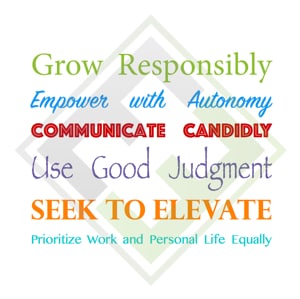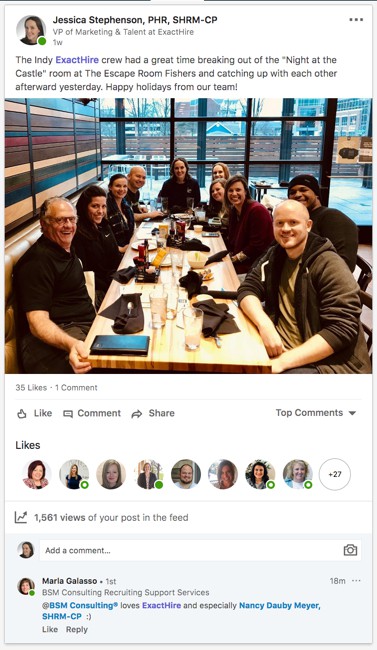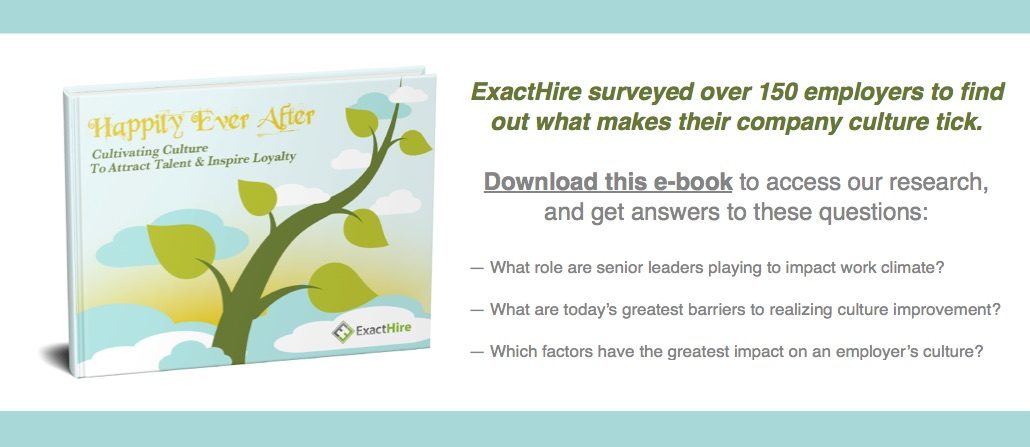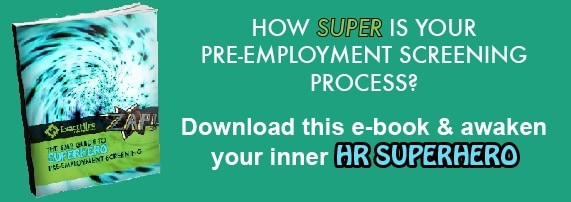Weave “Why” Into the Hiring Process, Or Don’t Bother Recruiting!
Have you thought about your organization’s “why” lately? Why do you exist as an employer and is it compelling inspiration for your employees and for job seekers?
I’ve been thinking about this a ton lately, and when I kept on hearing about Simon Sinek’s book, Start With Why, during my weekly digest of business podcasts I decided to listen to the audiobook. I’m seven years late to the party as it was first published in 2011. Sinek was talking about this in his TED Talks even earlier; yet, this idea is still relevant today.
Many of Sinek’s business examples (e.g. Apple, Southwest Airlines) focus on how clarity around their why inevitably drove customer acquisition and retention. Customers will buy from brands that inspire them, and what resonates for one person will fall flat for another.
In the book, Sinek shared how former Southwest Airlines CEO, Herb Kelleher, championed this belief with the culture he fostered in his organization. Years after Kelleher’s death, his legacy lives on in a still powerful culture that endeavors to give everyone the freedom to fly. In fact, my nephew Andrew, a airplane mechanic with Southwest Airlines, is a prime example.
Andrew and his wife were on vacation returning from the Pacific Northwest last year when their Southwest flight was at risk for further delays due to mechanical issues. Although my nephew had never worked at that airport (which was not a Southwest hub) and was not on the clock, he realized they were short on mechanics due to an extenuating circumstance. Consequently, he informed them that he was a Southwest mechanic and volunteered to assist in the time of need. He was motivated to help his family to have the freedom to fly home more quickly; however, Southwest still had to be responsive to empower him to step in at an unfamiliar location. They did respond, it worked out and he was commended in an all company publication shortly thereafter–a public reinforcement of Southwest’s why.
Having clarity about the purpose of an organization benefits the recruitment process and employee retention, too. In fact, inspiring job seekers and employees is even more important than customers, because without the passionate commitment of your employees, your customers won’t be inspired either.
Align recruiting strategy with your why
Are you currently painting the picture of why you exist to your potential future workforce? If you’re not sure, then you may be leading with the “how” and “what” of your organization (like so many employers) rather than following Sinek’s “Golden Circle.” In the circle, why always precedes how and what.
Remember, a candidate’s experience in your recruiting and hiring process will drive whether they believe your culture is true to the expectation you set. You must craft an experience that exudes your organizational why in order to truly engage job candidates.
At ExactHire, a piece of our why is to use technology to enable flexibility that allows people to balance work and personal life. That element of championing employment that accommodates your own lifestyle is repeated in our sixth and final core value.

Our work to truly articulate our ExactHire why is a work in progress, which can sometimes be frustrating. Nevertheless, enrichment is often realized in the journey more than the destination. Our newer journey has led us to build a new hiring software application that embodies the piece of our why that champions flexibility in the employment experience. Its first release will especially serve employers of large numbers of hourly, relatively interchangeable positions. This is the applicant sourcing world of “Just In Time” (JIT) hiring, and if that recruiting reality resonates with you, then you already know that it demands flexibility.
Weaving our why into hiring process design
The essence of our employment experience is previewed to candidates via the structure and activities involved with our recruiting and onboarding process. We think intentionally about incorporating our why throughout our hiring process.
Hiring process stakeholders
Before I ever post a new job opening at ExactHire, internally we’ve planned which teammates will be involved at which step in the process, as well as what their objective is in participating (e.g. questions to answer, information to impart). We talk to candidates during interviews about how the trust we place in employees allows us to enjoy flexibility in our working schedules. We can instill that trust due to the careful vetting process job candidates undergo. The ones who make it have chosen not to withdraw from the process despite our consistent candor about what it’s really like to work at ExactHire.
Additionally, the technology that we develop (which we use in our own recruiting process of course) must be flexible to
- meet candidates where they are,
- allow them to communicate in the manner that they prefer, and
- nurture their current engagement level (even if they aren’t ready to make a move yet).
Hiring process steps
Since our why focuses on flexibility, then our how must include regular, clear communication. At the onset of every ExactHire candidate’s recruiting experience, we describe all the interview steps involved in the hiring process, as well as how long we generally review candidates at each stage. There is nothing secret about the steps we take to hire; if we aren’t up front with what is required and our preferred time frame, then we’ll waste the candidate’s time and our time with people who can’t accommodate our needs. We treat people like adults and trust them to opt out if the career opportunity we’re serving isn’t appetizing.
We recently interviewed candidates for an additional salesperson for our team, and for this particular job, the following steps helped us demonstrate our why:
- Short, initial employment application – While we have many questions for applicants, we recognize that they won’t answer all of them in the first step. So, we only ask a few key questions at the onset.
- Phone interview – While this is a somewhat traditional approach to screening candidates, if we’re hiring for an inside sales position then phone presence is critical to assess.
- Remainder of employment application – Once candidates have been engaged during the phone interview, they are more flexible to complete the remaining questions on our application.
- Behavioral and cognitive assessment – These tools provide us with great data, but that data is only actionable for us because we know our why and which assessment scales are most critical in supporting that why.
- Video interview – For our recent salesperson selection process, we did a video conference interview instead of an in-person interview to flexibly accommodate everyone’s schedule more easily. Video presence is also an important skill to assess given that modern technology has made it easy for some sales calls to be done via video conference.
- Job shadow – The final step in our hiring process is a hands-on session during which the candidate experiences what it’s really like on the job and makes sure it is the right fit. He/she can experience our why first-hand.
Job description language
I support Sinek’s suggestion to be brutally honest about the realities of a job. After all, you want to hire people that want the job that you actually have, not one that you bait them with in an airbrushed job description. Here are some tips for incorporating why into your job descriptions.
Don’t hide your warts
Be honest about the thornier aspects of the role and your company. For ExactHire, that means I’ve included job listing truths like
- our web developers work longer hours while we build a brand new application,
- we have a 401K plan but no corporate match,
- due to our small company size you must have a trailblazing mentality–as there is not always a precedent for situations you encounter, and
- employees must be resourceful and seek help from our whole team–they can’t depend only on their boss.
Highlight your best features
Don’t forget to showcase your organization’s strengths, too. Focus on ones that lend authenticity to your company’s why. For us, these include
- a relatively flexible work schedule (e.g. I don’t have to use PTO to take my kids to the dentist),
- the ability to telecommute, and
- the chance to impact the entire organization and be empowered to help our clients bring flexibility to their job seekers and employees, too.
Be practical
If you only focus on the why in your job title and description, then you will be doing yourself a disservice. For example, you should still use job-relevant keywords in the description because not all employers will attract the same kind of job seeker attention that Simon Sinek does when he posts a job. While your job description should inspire the right job seekers, it can inspire on a larger scale if it’s able to be found via keyword-relevant queries on search engines and job boards.
Appreciate quality over quantity
With brutal honesty in your job description and thoughtful consideration for your organizational why, know that you may not be flooded with applicants. However, the quality of candidates you receive and your potential for cultivating longer employment tenure will be much better.
If you can’t tolerate the thought of fewer applicants as a result of better articulating your why and your expectations, then you’ve either completely missed your why; or, your why isn’t compelling enough when conveyed in its present form.
Employment brand champions
No matter how pervasive your why is across the organization, some employees are better advocates for your company purpose than others. Identify these teammates and spotlight them on your careers site, in social media and print, and within your interviewing process.
Consider using video testimonials with employees telling personal stories about how they identify with the vision of the employer. Also, create blog content that paints a picture of why (or why not) certain types of people should work for the company. Authentic, employee-inspired content does a fantastic job of setting expectations with job seekers regarding their potential fit with your organization.
Engagement during pre-boarding phase
The time between when a candidate accepts an offer and when he actually begins work is a delicate phase. I’ve seen organizations stood up by new hires on day one because the new candidates were not engaged by the organization appropriately during this pre-boarding period.
Reduce new hire “buyer’s remorse” by sharing examples of your company living up to its why during pre-boarding. During our recent recruitment process, I sent a photo of the team enjoying our annual holiday event on a Monday afternoon to remind our yet-to-start new hire of our focus on work-life balance.
This type of image is great content for the company social media profiles, as well. It helps illustrate your why to additional passive job seekers and existing employees and partners.

Employee onboarding
Senior leaders are caretakers of the company why. They must support the vision and inspire others through their actions. Involve these leaders in your new hire onboarding process–whether they sit down and meet directly with new hires or record a video that is shared during the first week of employment.
Due to the scope of their positions with the organization, they are generally busy people and it can be hard to find time to align them with the onboarding process to help support the why. However, while their frequent focus on profits, product features or service agreements is critical, without their attention directed to a compelling why your offering may be at risk of becoming just a commodity.
Keep walking the talk – don’t blame others
Organizations should put their best foot forward to support the why during the hiring process; however, don’t make the mistake of forgetting to reiterate the why to long-term employees, too. While it is a group effort, you have a stake in supporting the vision as well. So, what should you do if you find yourself among co-workers who are disengaged or a supervisor who isn’t representing the why?
While it can be easy to blame others and try to change their behavior, your best chance of making a difference is to be the rising tide.
“If you want to change someone else, change yourself. People change because they’re inspired by someone else’s example, not because they were coerced into doing it.” – Rachel Hollis
What about when you are the one needing the lift–especially this time of year? I can relate and offer this advice. While I can’t snow bird just yet to escape the drab, bone-chilling cold of the Midwest in winter, I can fight any of my own creeping disengagement by creating opportunities for us all to be more engaged.
“If you wish to feel more engaged, fulfilled and happy at work, make it your obsession to help the people around you find more engagement, fulfillment and happiness in their jobs.” – Simon Sinek
I was inspired by a conversation with a co-worker recently to start an optional quarterly book club at work. And while Start With Why isn’t actually our first reading assignment, we have chosen Radical Candor by Kim Scott. I believe it will help us dig into better articulating ExactHire’s why and where we still need some work connecting to it.
Don’t undervalue the business why
You can’t get this part wrong. If you do, it will weaken everything in your company. While inertia may sustain the organization for awhile, eventually the most talented people will leave to seek more challenge and/or something energizing or inspiring to support.



